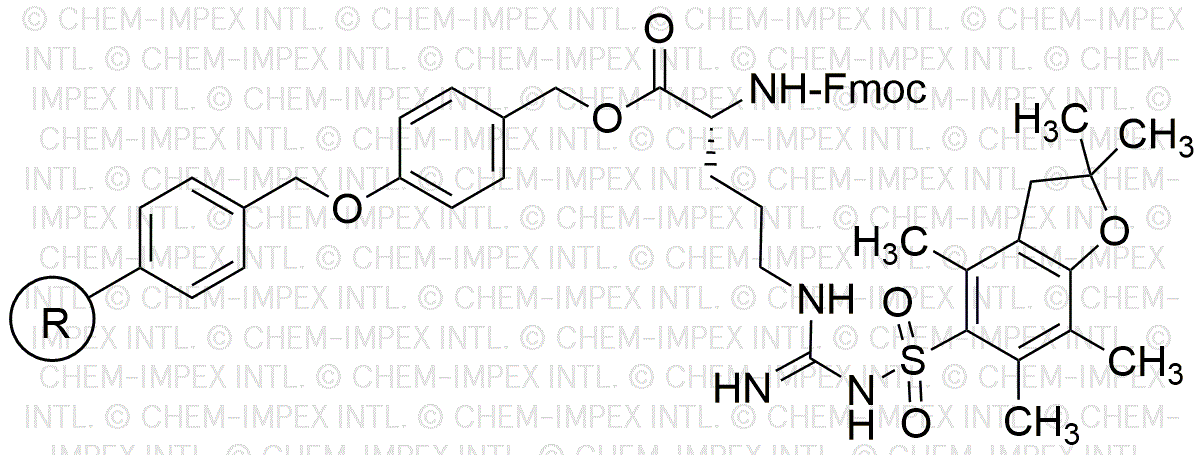Na-Fmoc-Nw-(2,2,4,6,7-pentamethyldihydrobenzofuran-5-sulfonyl)-D-arginine 4-alkoxybenzyl alcohol res is widely utilized in research focused on:
- Peptide Synthesis: This compound serves as a crucial building block in the synthesis of peptides, allowing researchers to create complex molecules for drug development.
- Bioconjugation: It is used in bioconjugation processes to attach biomolecules to surfaces or other molecules, enhancing the functionality of therapeutic agents.
- Drug Delivery Systems: The compound can be incorporated into drug delivery systems, improving the targeted delivery of therapeutic agents to specific cells or tissues.
- Research in Neuroscience: Its unique structure makes it valuable in neuroscience research, particularly in studying receptor interactions and signaling pathways.
- Development of Diagnostic Tools: This chemical is also applied in the development of diagnostic tools, aiding in the detection of diseases through innovative biosensing technologies.
General Information
Properties
Safety and Regulations
Applications
Na-Fmoc-Nw-(2,2,4,6,7-pentamethyldihydrobenzofuran-5-sulfonyl)-D-arginine 4-alkoxybenzyl alcohol res is widely utilized in research focused on:
- Peptide Synthesis: This compound serves as a crucial building block in the synthesis of peptides, allowing researchers to create complex molecules for drug development.
- Bioconjugation: It is used in bioconjugation processes to attach biomolecules to surfaces or other molecules, enhancing the functionality of therapeutic agents.
- Drug Delivery Systems: The compound can be incorporated into drug delivery systems, improving the targeted delivery of therapeutic agents to specific cells or tissues.
- Research in Neuroscience: Its unique structure makes it valuable in neuroscience research, particularly in studying receptor interactions and signaling pathways.
- Development of Diagnostic Tools: This chemical is also applied in the development of diagnostic tools, aiding in the detection of diseases through innovative biosensing technologies.
Documents
Safety Data Sheets (SDS)
The SDS provides comprehensive safety information on handling, storage, and disposal of the product.
Product Specification (PS)
The PS provides a comprehensive breakdown of the product’s properties, including chemical composition, physical state, purity, and storage requirements. It also details acceptable quality ranges and the product's intended applications.
Certificates of Analysis (COA)
Search for Certificates of Analysis (COA) by entering the products Lot Number. Lot and Batch Numbers can be found on a product’s label following the words ‘Lot’ or ‘Batch’.
Numéro de catalogue
Numéro de lot/série
Certificates Of Origin (COO)
This COO confirms the country where the product was manufactured, and also details the materials and components used in it and whether it is derived from natural, synthetic, or other specific sources. This certificate may be required for customs, trade, and regulatory compliance.
Numéro de catalogue
Numéro de lot/série
Safety Data Sheets (SDS)
The SDS provides comprehensive safety information on handling, storage, and disposal of the product.
DownloadProduct Specification (PS)
The PS provides a comprehensive breakdown of the product’s properties, including chemical composition, physical state, purity, and storage requirements. It also details acceptable quality ranges and the product's intended applications.
DownloadCertificates of Analysis (COA)
Search for Certificates of Analysis (COA) by entering the products Lot Number. Lot and Batch Numbers can be found on a product’s label following the words ‘Lot’ or ‘Batch’.
Numéro de catalogue
Numéro de lot/série
Certificates Of Origin (COO)
This COO confirms the country where the product was manufactured, and also details the materials and components used in it and whether it is derived from natural, synthetic, or other specific sources. This certificate may be required for customs, trade, and regulatory compliance.

